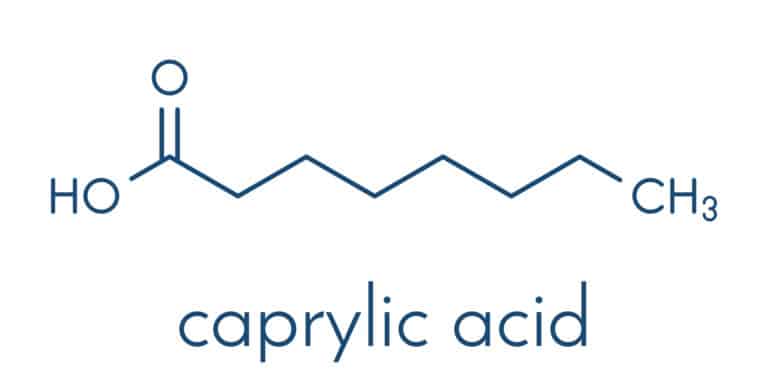Caprylic acid

Origin and properties of caprylic acid
Caprylic acid is the INCI name for octanoic acid, a natural, medium-chain (MCT) and saturated fatty acid found in human milk fat as well as in coconut oil, butter, palm oil and many other sources. The name caprylic acid probably comes from the Latin for goat (capra), because the substance is found in increased amounts in goat’s milk and goat’s butter. The proportion in 100 grams of goat’s milk can be as high as 2700 milligrams. By comparison, 100 grams of cow’s milk contains only 1300 milligrams of caprylic acid. However, coconut oil is the frontrunner, with up to 9500 milligrams of octanoic acid in 100 grams. In its pure form, the acid appears as a colourless oil. It has a slightly burning taste and a slightly rancid odour. It is not very soluble in water, but can be mixed well with organic solvents. Caprylic acid is liquid at room temperature (20°C) because its melting point is 17°C. It boils at 237°C. Its salts and esters are called caprates and octanoates.
Use in the cosmetics industry
Why have we gone into all this? Because caprylic acid is very often found in cosmetic products, and for good reason. The acid is used, for example, as an emulsifier because it helps to stabilise oil and water phases, resulting in a homogeneous mass. It is also an effective consistency enhancer, as it can create a non-greasy and pleasantly light texture on the one hand, but also improves the viscosity of the formulations on the other. In addition, caprylic acid is an ideal moisturiser. The acid helps to keep the skin elastic and supple by contributing to an optimal supply of moisture. But the active ingredient scores even more points with other good properties and advantages. It also has microbial properties, which means that it can help to improve the shelf life of cosmetic formulations by inhibiting the growth of microorganisms such as fungi and bacteria. In this case, it serves as a natural preservative and is therefore often used in natural cosmetics.
Use in industry and medicine
In industry, caprylic acid is often used in the production of dyes and soaps. We also find the acid in many insect sprays. Since it is not a classic insecticide, these insect sprays are often offered as a natural product. However, they are very effective because the acid simply dissolves the chitinous exoskeleton of insects. These then die from it. Caprylic acid also has valuable uses in the medical field. For example, it can help with some bacterial infections and with candida, or fungal infections. It is particularly effective against the pathogenic yeast candida albicans. This is because caprylic acid attacks the cell membrane of candida albicans, making it unstable and killing the cell.
Safety and tolerability of caprylic acid
Caprylic acid is therefore an extremely versatile and at the same time very effective active ingredient that has proven to be extremely safe and reliable over the years. Due to its various modes of action and functions, as well as its natural origin, it is very popular in the cosmetics industry, and rightly so. It is therefore no wonder that it appears on the INCI list of numerous high-quality cosmetic products, especially since it is considered to be well tolerated. There are no known disadvantages worth mentioning. The only restriction is the oral intake of caprylic acid as a micronutrient. Such preparations are used, among other things, to regulate the intestinal flora, as part of a ketogenic diet or as an additional source of energy for brain metabolism. Among others, people with liver disease, certain cancers, heart failure and low blood pressure should refrain from consuming caprylic acid. There are not yet sufficient studies available for its use during pregnancy and breastfeeding. However, these precautions actually only apply to oral intake. If caprylic acid is contained in cosmetic products for external use, no special restrictions apply. However, possible allergic reactions cannot be completely ruled out in individual cases. Overall, however, the benefits of caprylic acid clearly outweigh any risks.
Description of caprylic acid
INCI: Caprylic Acid CAS number: 127-07-2 Molecular formula: C8H16O2 Description: colourless liquid Alternative term: heptane carboxylic acid pKs value: 4.89 Density: 0.91 g/cm3 Molar mass: 144.2 g·mol-1 Applications: as a moisturiser, emulsifier, consistency enhancer and natural preservative
Caprylic acid: a high-quality active ingredient for cosmetic formulations
Octanoic acid is not only highly versatile, it is also very effective and pleasantly light and non-greasy, allowing it to be quickly absorbed by the skin. Thanks to its microbial properties, it also helps to improve the stability and shelf life of cosmetic formulations. Another advantage: caprylic acid is an ideal carrier substance in vitamin creams. Since many vitamins are fat-soluble and can therefore only penetrate the skin through the fat content of the formulation, caprylic acid is an ideal solution, especially since artificial fats such as mineral oil hardly work as a carrier substance, if at all. Contact us if you are interested in high-quality cosmetics with caprylic acid! Literature: Propanediol (and) Caprylic Acid (and) Xylitol as a New Single Topical Active Ingredient against Acne: In Vitro and In Vivo Efficacy Assays.
Mussi L, Baby AR, Camargo Junior FB, Padovani G, Sufi BDS, Magalhães WV.Molecules. 2021 Nov 5;26(21):6704